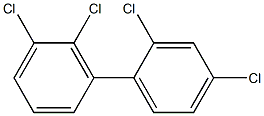Chemical Properties
Clear; mobile liquid; approximately 3.1
chlorine atoms per molecule.
Physical properties
Colorless to light yellow, viscous, oily, dense, nonflammable liquid with a weak, hydrocarbon or
aromatic-type odor
Uses
Dielectric liquids; in fixed paper capacitors; heat-transfer liquid widely used in transformers
and utility transmission lines; swelling agents for transmission seals; ingredient in lubricants, oils,
and greases; plasticizers for cellulose products, vinyl, and chlorinated rubbers; in polyvinyl acetate
to improve fiber-tear properties. In fluorescent and high-intensity discharge ballasts manufactured
prior to 1979 (U.S. EPA, 1998) and in electric motors (Monsanto, 1960).
Prior to being banned in 1976, PCB-1254 was used in home appliances including air
conditioners, furnaces, washers, and driers. May have been added to automotive transmission oils
to swell shrunken transmission seals in place (Monsanto, 1960).
At a concentration of 5 to 25 wt %, increased the effective kill-life of the lindane spray up to 10
times. May have been used in chlordane and BHC insecticide formulations. In polyvinyl acetate
emsulsions to impart strong bonding power in adhesives. In various nitrocellulose lacquers to impart weather resistance, luster, adhesion, and decreased burning rate. These lacquers may also
contain tricresyl phosphate (Monsanto, 1960).
Uses
Dielectric in capacitors and transformers;
investment casting processes; heat
exchange fluid; hydraulic fluid; no longer produced
in the US
Definition
AROCLOR 1242, 1X1ML, ISO, 1UG/ML is a polychlorinated biphenyl.
General Description
Viscous oily liquid.
Air & Water Reactions
Insoluble in water.
Reactivity Profile
Simple aromatic halogenated organic compounds are very unreactive. Reactivity generally decreases with increased degree of substitution of halogen for hydrogen atoms.
Health Hazard
Chlorodiphenyl, 42% chlorine
(one of over 200 possible chlorinated
compounds that comprise polychlorinated
biphenyls or PCBs) is an irritant of the eyes and mucous membranes, is toxic to the liver, and
causes an acneform dermatitis (chloracne). It is
a liver carcinogen in animals.
Fire Hazard
Some may burn but none ignite readily. Containers may explode when heated. Some may be transported hot.
Safety Profile
Suspected human
carcinogen. Poison by subcutaneous route.
Mildly toxic by ingestion. Human systemic
effects by inhalation: pulmonary and liver
effects. Experimental reproductive effects.
Mutation data reported. When heated to
decomposition it emits toxic fumes of Cl-.
Used in heat transfer, hydraulic fluids,
lubricants, and insecticides. See also
POLYCHLORINATED BIPHENYLS.
Carcinogenicity
The genotoxicity of PCBs has been tested
in in vivo and in vitro studies with generally
negative results.
Environmental Fate
Biological. A strain of Alcaligenes eutrophus degraded 81% of the congeners by dechlorination
under anaerobic conditions (Bedard et al., 1987). A bacterial culture isolated from Hamilton
Harbour, Ontario was capable of degrading a commercial mixture of PCB-1242. The metabolites
identified by GC/MS included isohexane, isooctane, ethylbenzene, isoheptane, isopropylbenzene,
n-propylbenzene, isobutylbenzene, n-butylbenzene, and isononane (Kaiser and Wong, 1974). A
strain of Pseudomonas, isolated from activated sludge and grown with biphenyl as the sole carbon
source, degraded 2,4′-dichlorobiphenyl yielding the following compounds: two monochlorobenzoic
acids, two monohydroxydichlorobiphenyls, and a yellow hydroxyoxo(chlorophenyl)
chlorohexadienoic acid. Irradiation of the mixture containing these compounds led to the
formation of two monochloroacetophenones and the disappearance of the yellow compound.
Similar compounds were found when 2,4′-dichlorobiphenyl was replaced with a PCB-1242
mixture (Baxter and Sutherland, 1984).
Soil. In Hudson River, NY sediments, the presence of adsorbed PCB-1242 in core samples
suggests it is very persistent in this environment. The estimated half-life ranged from 1.3 to 2.1 yr
(Bopp et al., 1982).
Photolytic. PCB-1242 in a 90% acetonitrile/water solution containing 0.2 to 0.3 M sodium
borohydride and irradiated with UV light (λ = 254 nm) reacted to yield dechlorinated biphenyls.
Without sodium borohydride, the reaction proceeded much more slowly (Epling et al., 1988).
Chemical/Physical. When PCB-1242-contaminated sand was treated with a poly(ethylene
glycol)/potassium hydroxide mixture at room temperature, 27% reacted after 2 wk forming aryl
poly(ethylene glycols) (Brunelle and Singleton, 1985).
Solubility in water
(wt %):
Benzoic acid (10.0 at 31 °C), pyridine (132.5 at 30 °C), diglycol monoethyl ether (224 at 31 °C),
methanol (42.5 at 29 °C), ethanol (23.3 at 29 °C) (Monsanto, 1960)





